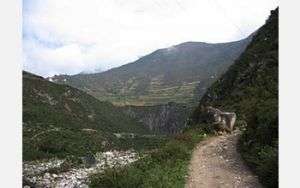Long Wait Before Next China Quake?

A new analysis of the setting for May's devastating earthquake in China shows that the quake resulted from faults with little seismic activity--and that similar events in that area occur, on average, only once every 2,000 to 10,000 years. However, geologists caution that because earthquakes can sometimes occur in clusters, people should still be wary of another possible large-scale earthquake.
Clark Burchfiel and Leigh Royden, geologists at MIT, have done extensive research in China for more than two decades but had found no hints that suggested such a large earthquake might strike the area.
They and colleagues, including MIT's Robert van der Hilst and Bradford Hager, have published a paper analyzing the causes of the quake in the July issue of the journal GSA Today.
"This is an excellent example of how long-term support of basic research can provide valuable insights into the cause of a major natural disaster," says Leonard Johnson, program director in the National Science Foundation's Division of Earth Sciences, which funded the research.
The magnitude 7.9 quake struck Sichuan province on May 12, 2008, at around noon, which may have increased the human death toll because many children were at school. The school buildings turned out to be especially vulnerable to collapse because of poor construction.
More than 69,000 people have been confirmed dead, and more than 374,000 injured, with fears of further casualties because several lakes created by rockfall dams may give way and cause sudden flooding.
The geologists operated an array of 25 broadband seismograph stations in this region of western Sichuan for more than a year.
"Nobody was thinking there would be a major seismological event in that area," Royden says. "This earthquake was quite unusual, and may have involved a simultaneous rupture of two separate but contiguous faults."
The region is extremely unusual geologically because of the very steep slopes at the boundary between the Sichuan Basin to the east and the Tibetan plateau to the west. The elevation rises sharply by about 3,500 meters (more than two miles) over a span of only about 50 kilometers (about 30 miles).
The area where the quake occurred is part of the boundary between two of the Earth's tectonic plates. The Indian and Asian plates converge in an ongoing collision that created the Himalayan mountains and the Tibetan plateau.
But in central and eastern Tibet, unlike most other areas of such collision, much of the movement of crust is hidden from view.
The elevation difference between the surface of the plateau and the Sichuan Basin provided the underlying stress that led to the quake.
As the surface of the eastern plateau has risen, it has become increasingly incised by rivers. Four of the world's 10 largest rivers, including the Yangtze, flow through the region. "There are gorges two and a half to three kilometers deep and hundreds of kilometers long--they dwarf the Grand Canyon," says Royden. Steep slopes in the river gorges make the region especially vulnerable when earthquakes occur. "When you shake those valleys, everything just slides down into the river gorges and eventually washes out to sea," she says.
Because of the extreme geology of this region, it may be possible to learn about similar mechanisms that also occur on a smaller scale in other places.
Source: NSF




















